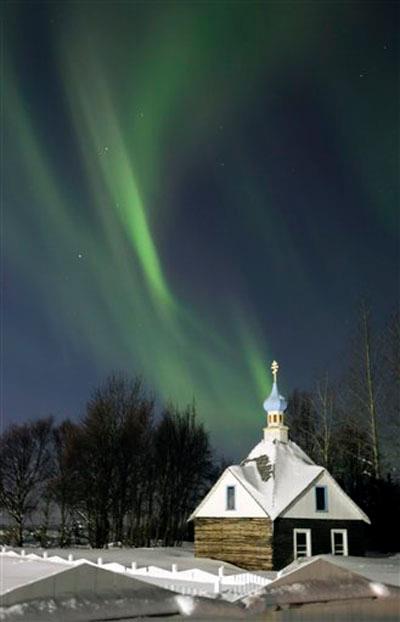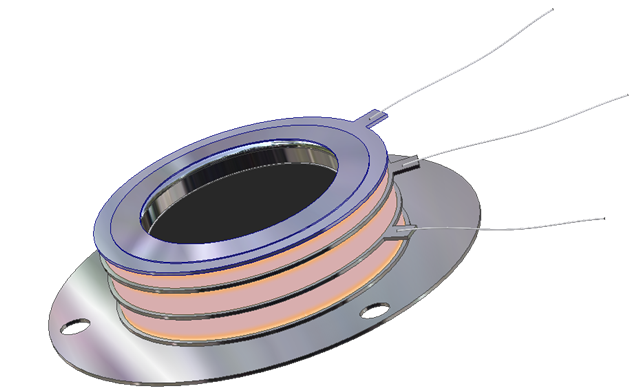
Del Mar Photonics - Newsletter - Request a quote for MCP detector
FAIRBANKS, Alaska—After days of waiting for precise aurora conditions, a team
from the University of Iowa finally saw the launch of its two scientific
sounding rockets from Poker Flat Research Range. The NASA rockets launched Jan.
29, just before 1 a.m. Alaska Standard Time, and flew through an auroral
curtain, collecting data throughout their flights. Scientists with the Auroral
Current and Electrodynamics Structure mission, or ACES for short, aimed to gain
a clearer picture of aurora structure by simultaneously collecting data from
both the top and bottom edges of an auroral arc. To get the data, two rockets
were launched. A two-stage Black Brant IX launched at 12:49 a.m. and reached an
altitude of more than 226 miles. The rocket flew for just under 10 minutes. At
12:50 a.m., a single-stage Black Brant V launched, reaching an altitude of
nearly 83 vertical miles, flying for roughly eight minutes. The payloads of each
ACES rocket performed well during flight. Principal Investigator Scott Bounds of
the University of Iowa and the ACES team will begin to analyze all of the data
collected, which should keep them busy for the next year. Bounds said this
information will help refine current models of aurora structure. The ACES
mission will provide insight on the structural subtleties of the aurora, details
that researchers may have missed when previous measurements were done using only
a single vehicle.
The ACES rockets were loaded onto launchers and had been ready to fly since Jan.
14. Each evening scientists scanned the sky with cameras at local and downrange
sites for a sufficient auroral arc to appear just north of Fort Yukon. A stable,
thin arc was required for the experiment to perform optimally and finally that
arc appeared early on Jan. 29. Bounds, from the Department of Physics and
Astronomy at the University of Iowa, worked on six previous launches from Poker
Flat Research Range as a postdoctoral fellow and as a coinvestigator.
The ACES mission is the first project he's managed as the principal
investigator.
"I certainly feel relieved now that we've launched," Bounds said. "The pressure
was much greater before today."
Bounds and his team aren't taking much time to re-group. The team plans to
return to Poker Flat Research Range in 2010, as the University of Iowa is a
collaborator for another launch scheduled at the range.
Poker Flat Research Range is the largest land-based sounding rocket range in the
world. It's located 30 miles north of Fairbanks on the Steese Highway. The
Geophysical Institute at the University of Alaska Fairbanks operates the range
under contract to NASA.
Request a
quote for MCP detector
Category:
Science & Technology
Tags:
instruments for rockets meaurements of energy flux coming it what energizing
aurora energetic electrons ions lateral electromagnetic waves other planets
stellar atmosphere laboratory space suborbital surplus military NASA sounding
rocket detecting the that cause microchannel plate magnetic field ACES Auroral
phenomena Field-aligned currents current MAGNETOSPHERIC PHYSICs Top-hat
electrostatic analyzer
Request a
quote for MCP detector
The northern lights or aurora borealis fill the western sky Friday, March 9, 2012, above the Russian Orthodox Saint Nicholas Memorial Chapel in Kenai, Alaska. The display of lights came in the aftermath of a solar storm that struck Earth on Thursday. (AP Photo/Peninsula Clarion, M. Scott Moon)

Featured Product:
 |
Open Microchannel Plate Detector
MCP-MA25/2 -
now in stock! -
Request a quote for MCP detector |
Microchannel Plates, Detectors
and Imaging Systems
Examples of research applications:
Studies of the atomic clusters at the
University of Virginia -
Amber Post
Featured MCP customer:
The Castleman Group at PSU
MCP home -
MCP references -
Absolute ion detection efficiencies of a microchannel plate -
How to choose
MCP detector
MCP-GPS-46/2-CF6" Open
MCP imaging detector mounted on CF6" flange -
MCP-GPS and
MCP-IFP imaging detectors
MCP-MA -
Detecting short proton
beam from a picosecond CO2 laser ionized H2 plasma
MCP-MA25/2 are used in aSPECT to
study the background
MCP setup for velocity map imaging apparatus
Microchannel Plate Detector (MCP) setup for Plasma Desorption Mass
Spectrometry (PDMS)
MCP detector for high resolution ion time-of-flight analysis for measuring
molecular velocity distributions
X-ray detection system based on the MCP/phosphor screen assembly
Analysis of biological molecules on surfaces using stimulated desorption
photoionization mass spectrometry
MCP detector for laser ablation/ionization experiment
A linear radiofrequency quadrupole ion trap for the cooling and bunching of
radioactive ion beams
MCP + phosphorous screen for imaging of XUV radiation (14eV- 160-eV) in high harmonics experiments
Exchanging MCPs in Time-of-Flight detectors
Publications:
Chen, L., C. A. Kletzing, S. Hu, and S. R. Bounds, Auroral electron dispersion
below inverted-V energies: Resonant deceleration and acceleration by Alfven
waves, J. Geophys. Res., 110, A10S13, doi:10.1029/2005JA011168, 2005.
C. A. Kletzing, S. R. Bounds, J. Martin-Hiner, W. Gekelman, and C. Mitchell,
Measurements of the shear Alfven wave dispersion for finite perpendicular wave
number, Phys. Rev. Lett, 10.1103/PhysRevLet.90.0350004, 2003.
C. A. Kletzing and S. Hu, Alfven Wave Generated Electron Time Dispersion,
Geophys. Res. Lett., 28, 693, 2001.
K. Stasiewicz, P. Bellan, C. Chaston, C. Kletzing, R. Lysak, J. Maggs, O.
Pokhotelov, C. Seyler, P. Shukla, L. Stenflo, A. Streltsov, and J.M--E. Wahlund,
Small Scale Alfvenic Structures, Space Sci. Rev., 92, 423, 2000.
Kletzing, C. A., Electron Acceleration by Shear Alfven Waves in a Cylindrical
Geometry, poster presentation to IPELS '97 conference, July, 1997.
Kletzing, C. A., Sharp Boundaries and Dispersion of Inertial Alfven Waves, EOS
suppl., 78, S269, 1997.
Kletzing, C. A., Electron Acceleration by Kinetic Alfven Waves, J. Geophys.
Res., 99 , 11095, 1994.
Electron Beam Electric Field Measurements
G. Paschmann, N. Sckopke, H. Vaith, J. M. Quinn, O. H. Bauer, W. Baumjohann, W.
Fillius, G. Haerendel, S. S. Kerr, C. A. Kletzing, K. Lynch, C. E. McIlwain, R.
B. Torbert, E. C. Whipple, EDI gyro time measurements on Equator-S, Annales
Geophysicae, 17, 1513, 1999.
Kletzing, C. A., G. Paschmann, and M. Boehm, Electric Field Measurements Using
the Electron Beam Technique at Low Altitudes, in Measurement Techniques in Space
Plasmas, AGU Monograph Series, 103. 53, 1998
Kletzing, C. A., G. Paschmann, M. H. Boehm, G. Haerendel, N. Sckopke, W.
Baumjohann, R. B. Torbert, G. Marklund and P.-A. Lindqvist, Electric fields
derived from electron drift measurements, Geophys. Res. Lett., 21, 1863, 1994.
Plasma Sheet Physics from Polar
C. A. Kletzing, J. D. Scudder, E. E. Dors, and C. Curto, The auroral source
region: plasma properties of the high altitude plasma sheet, J. Geophys. Res.,
J. Geophys. Res., 108, 1360, doi:10.1029/2002JA009678, 2003.
J. R.Wygant, A. Keiling, C. Cattell, R. L. Lysak, M.Temerin, F. S. Mozer, C. T.
Russell, and C. A. Kletzing, Correlation of Alfven wave Poynting flux in the
plasma sheet at 4-7 RE with ionospheric electron energy flux, J. Geophys. Res.,
107, 2002.
A. Keiling, J. R. Wygant, C. Cattell, M.Temerin, F. S. Mozer, C. A. Kletzing, J.
Scudder, C. T. Russell, Properties of large electric fields in the plasma sheet
at 4M--7 RE measured with Polar, Geophys. Res., in press, 2001.
A. Keiling, J. R. Wygant, C. Cattell, M.Temerin, F. S. Mozer, C. A. Kletzing, J.
Scudder, C. T. Russell, W. Lotko, and A. Streltsov, Large Alfven wave power in
the plasma sheet boundary layer during the expansion phase of substorms ,
Geophys. Res. Lett., 27, 3169, 2000.
J. R. Wygant, A. Keiling, C. A. Cattell, M. Johnson, R. L. Lysak, M. Temerin, F.
S. Mozer, C. A. Kletzing, W. Peterson, C. T. Russell, G. Parks, M. Brittnacher,
Polar Spacecraft Based Comparisons of Intense Electric Fields and Poynting Flux
Near and Within the Plasma sheet - Tail Lobe Boundary to UVI Images: An Energy
Source for the Aurora, J. Geophys. Res., 8, 18675, 2000.
Kletzing, C. A., and J. D. Scudder, Auroral-Plasma Sheet Electron Anisotropy,
Geophys. Res. Lett,, 26, 971, 1999.
Cattell, C. A., J. Dombeck, J. R. Wygant, M. K. Hudson, F. S. Mozer, M. A.
Termerin, W. K. Peterson, C. A. Kletzing, C. T. Russell, and R. F. Pfaff,
Comparisons of Polar satellite observations of solitary wave velocities in the
plasma sheet boundary and the high altitude cusp to those in the auroral zone,
Geophys. Res. Lett., 26, 425, 1999.
Other Polar Science
Toivanen, P. K. , Baker, D. N. , Peterson, W. K. , Singer, H. J. , Turner, N. E.
, Li, X. ; Kauristie, K. , Syrjasuo, M. ,Viljanen, A. , Pulkkinen, T. I. ,
Keiling, A. , Wygant, J. R. , Kletzing, C. A. 2001Reconciliation of the substorm
onset determined on the ground and at the Polar spacecraft Geophys. Res. Lett.
28, 107, 2001
Auroral Physics
Kletzing, C. A. and L. Muschietti, Phase correlation waves, in ”Geospace
Radiation and Plasma Waves”, J. LaBelle and R. A. Treumann, eds.,
Springer-Verlag, 2006.
C. A. Kletzing, S. R. Bounds, J. LaBelle, and M. Samara, Observation of the
reactive component of Langmuir wave phase-bunched electrons, Geophys. Res.
Lett., 32, L05106, doi:10.1029/2004GL021175, 2005.
M. Samara, J. LaBelle, C. A. Kletzing, S. R. Bounds, Rocket observations of
structured upper hybid waves at fuh = 2fce, Geophys. Res. Lett.,31, doi:
10.1029/2004GL021043, 2004.
D.Schriver, M. Ashour-Abdalla,R. J. Strangeway,R. L.Richard, C. Kletzing, Y.
Dotan, J. Wygant, FAST/Polar conjunction study of field-aligned auroral
acceleration and corresponding magnetotail drivers, J. Geophys. Res.,108, 8020,
10.1029/2002JA009426, 2003
Dors, Eric E., and C.A. Kletzing, Effects of Suprathermal Tails on Auroral
Electrodynamics, J. Geophys. Res., 104, 6783, 1999..
Kletzing, C. A., F. S. Mozer, R. B. Torbert, Electron Temperature and Density at
High Latitude, J. Geophys. Res., 103, 14837, 1998
Mozer, F. S. and C. A. Kletzing, Direct observation of large, quasi-static,
parallel electric fields in the auroral acceleration region, Geophys. Res.
Lett., 25, 1629, 1998.
Kletzing, C. A., G. Berg, M. C. Kelley, F. Primdahl, and R. B. Torbert, The
electrical and precipitation characteristics of morning sector S un-aligned
auroral arcs, J. Geophys. Res., 101, 17175, 1996
G. A. Berg, M. C. Kelley, M. Mendillo, R. Doe, J. Vickrey, C. Kletzing, F.
Primdahl, and K. B. Baker, Formation and eruption of Sun-aligned arcs at the
polar cap-auroral oval boundary, J. Geophys. Res., 99, 17577, 1994.
C. A. Kletzing and R. B. Torbert, Electron Time Dispersion, J. Geophys. Res., 99
, 2159, 1994 .
Education
J. C. Williamson, R. O. Torres-Isea, and C. A. Kletzing, Analyzing Linear and
Angular Momentum Conservation in Digital Movies of Puck Collisions, Am. J.
Phys., 68, 841, 2000.